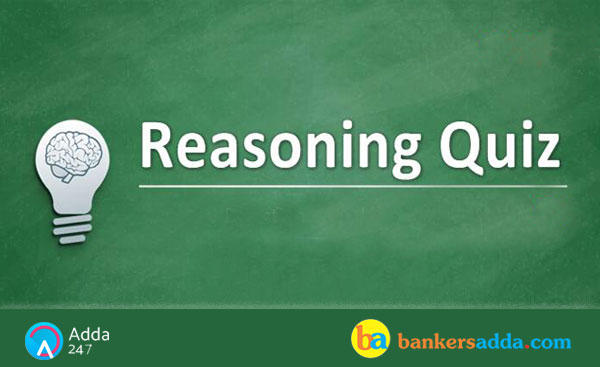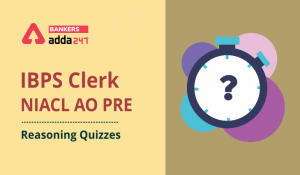Dear Aspirants,
Reasoning Ability is an onerous section. With the increasing complexity of questions, it becomes hard for one to give it a cold shoulder. The only way to make the grade in this particular section in the forthcoming SBI PO Prelims and other banking exams is to practice continuously with all your heart and soul. And, to let you practice with the best of latest pattern questions, here is the Adda247 Reasoning Quiz with the exact same pattern of questions that are being asked in the exams.
Directions (1-5): Study the following information carefully and answer the questions given below:
Ten friends L, M, N, O, P, Q, R, S, T, and U are sitting around a rectangular table in such a way that four of them sit at the corners, two each on the longer sides and one each on the smaller sides of the rectangle but not necessarily in the same order. Some of them are facing the center while some of them are facing outside the center. Not more than two friends sitting adjacent to each other faces the same direction. Each person likes a different car i.e. Jaguar, Ferrari, Fiat, Nissan, Suzuki, Rolls-Royce, Renault, Porsche, Toyota, and Ford but not necessarily in the same order.
P sits on the immediate left of O but he is not an immediate neighbour of N. L and P both faces the same direction. The one who likes Renault sits on the immediate left of the one who likes Rolls-Royce. O and R sit diagonally opposite to each other and faces opposite directions. S likes neither Rolls-Royce nor Suzuki. The one who likes Porsche sits on the immediate right of U, who likes Toyota. Only Five of them face the same direction. The one who likes Rolls-Royce sits second to the left of N. Only two among the four sitting on the four corners are not facing the center. S sits on the immediate left of T. L sits at one of the smaller side and third to the right of Q. O likes Jaguar and sits third to the left of the one who like Nissan. T sits on the immediate right of the one who likes Suzuki. P likes Ford and sits second to the left of the one who like Ferrari. U is not an immediate neighbour of L, M or Q. U sits on the immediate right of N, who is not facing the center. U is one of the four friends who sit at the corners. O sits third to the left of T.
Q1. Who is sitting diagonally opposite to U?
(a) The one who like the Fiat
(b) R
(c) O
(d) The one who like the Nissan
(e) None of these
Q2. Who sits second to Right of R?
(a) P
(b) L
(c) T
(d) J
(e) None of these
Q3. How many persons sit between O and P, when counted from left of O?
(a) Two
(b) One
(c) Three
(d) Four
(e) No One
Q4. Who is sitting opposite S?
(a) P
(b) L
(c) O
(d) M
(e) Q
Q5. What is the position of N with respect to O?
(a) Fourth to right
(b) Third to left
(c) Fifth to left
(d) Fourth to left
(e) Second to right
Directions (6-10): In each question below, are given a statement followed by two conclusions numbered I and II. On the basis of the information given in the statement, you have to assume everything in the statement to be true, and then decide which of the following conclusion follow(s).
Give answer:
(a) if only I follow.
(b) if only II follows.
(c) if either I or II follows.
(d) if neither I nor II follows.
(e) if both I and II follow.
Q6. Statement: A > C > N ≤ L > K > I ≤ H; I ≥ P > Q = S < T
Conclusions: I. C ≤ P II. T < L
Q7. Statement: P > M = Q ≥ N = L < K; F = S ≥ Q = Z > T
Conclusions: I. S = M II. M < S
Q8. Statement: D > H > N; K > I ≤ H
Conclusions: I. N ≤ K II. N < D
Q9. Statement: P ≤ O < M; P > Y > W
Conclusions: I. Y ≤ M II. O > W
Q10. Statement: Y ≤ B > C ≤ F; Z < C = D < E
Conclusions: I. Y > Z II. F < E
Directions (11-15): Study the information and answer the following questions:
In a certain code language
“Rightful due political economy” is coded as “S@12 E#5 Q#12 F#25”
“There are numerous ways ” is coded as “U#5 B#5 O@19 X@19”
“Work culture provide good” is coded as “X@11 D#5 Q#5 H@4”
Q11. What is the code for ‘neighbour’ in the given code language?
(a) M#20
(b) O#18
(c) N#18
(d) S#20
(e)None of these
Q12. What is the code for ‘proximity’ in the given code language?
(a) R#25
(b) M#25
(c) Q#25
(d) L#25
(e)None of these
Q13. What may be the possible code for ‘ Nothing good’ in the given code language?
(a) O#7 H@4
(b) S@5 X#12
(c) O@5 H#15
(d) T@5 W#12
(e)None of these
Q14. What may be the possible code for ‘great scholar’ in the given code language?
(a) X#7 V@5
(b) H#20 T#18
(c) H@7 T@5
(d) G#7 T@5
(e)None of these
Q15. What is the code for ‘ publicly enforcing’ in the given code language?
(a) R@25 F#7
(b) Q#25 F#7
(c) Q@25 F@7
(d) Q@12 F#14
(e)None of these





 Reasoning Ability Quiz For IBPS Clerk/NI...
Reasoning Ability Quiz For IBPS Clerk/NI...



